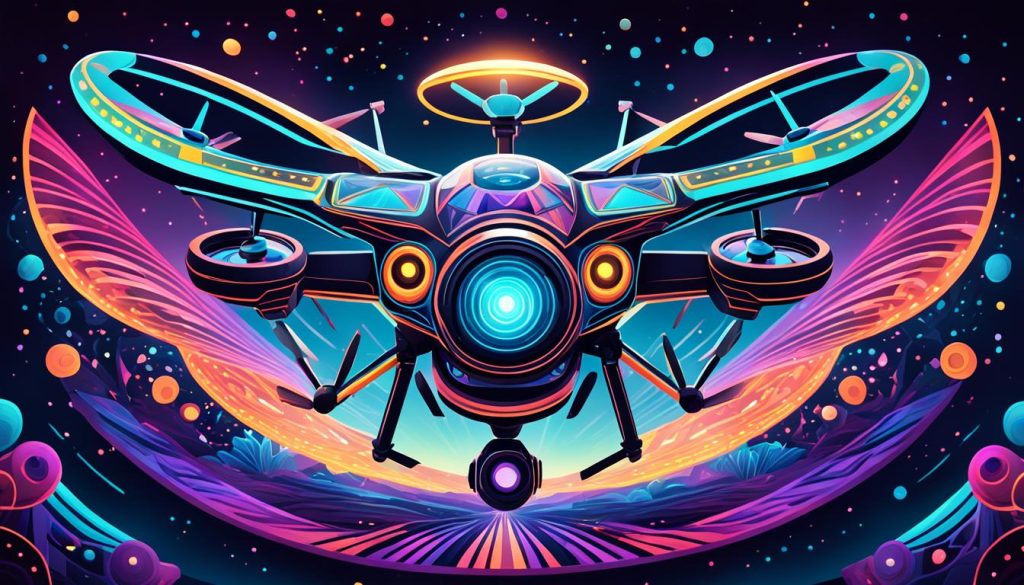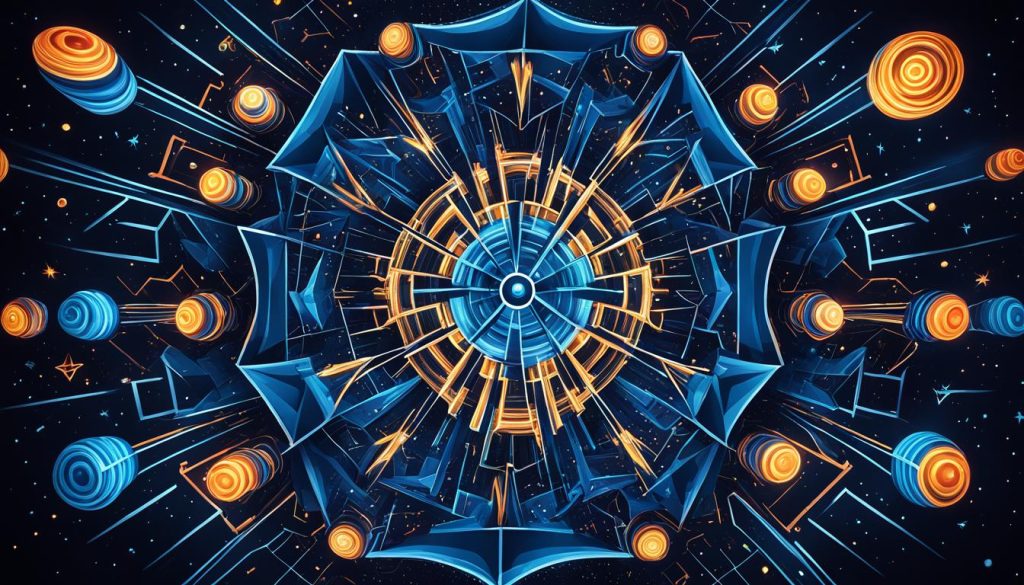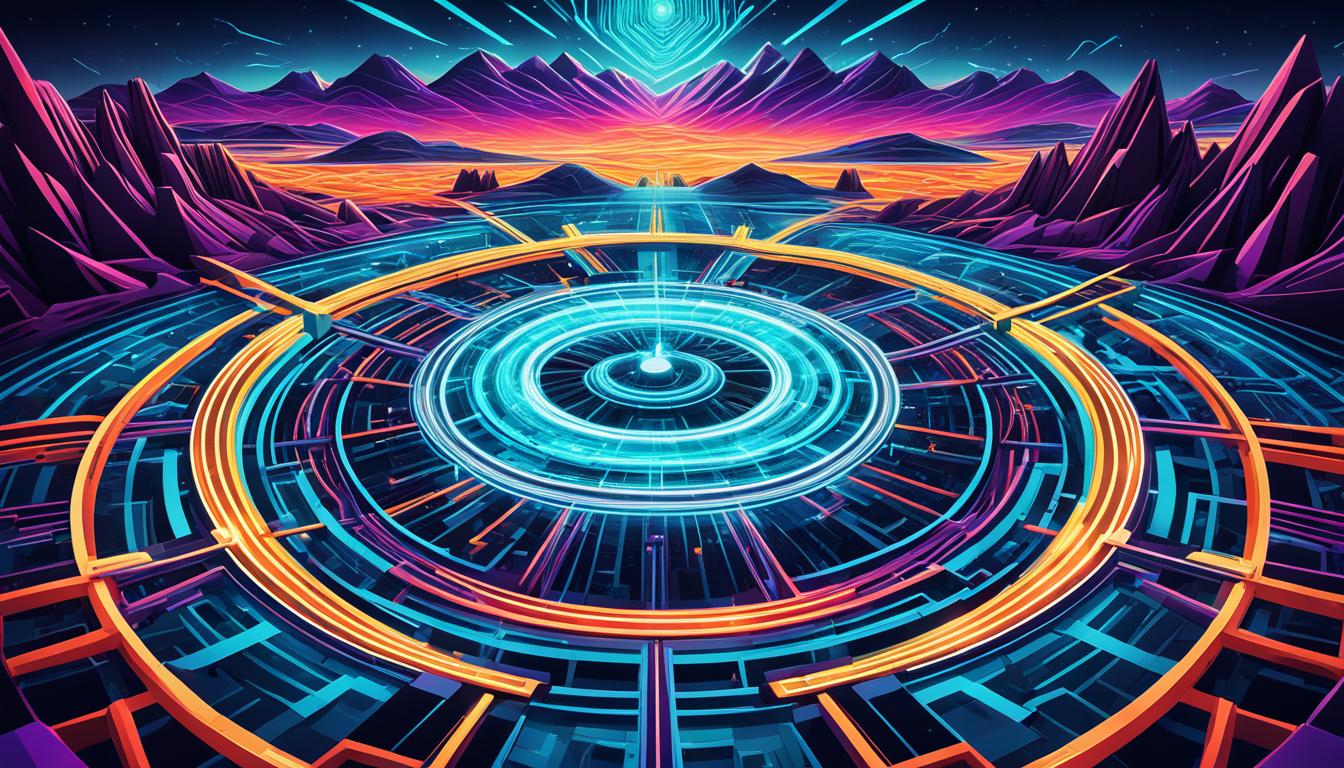You can make amazing geometric patterns in the sky with drones and light painting. This cool method lets you create beautiful scenes with drones that have LED lights. You use them against the night sky.
Drone photography becomes more exciting when you try light trail images. Plan your shots well and move your drone just right. You’ll get pictures that look like patterns dancing in the sky.
To start, set up your camera for long shots. Then, plan your drone’s flight path. Pick the best place for your light art. With time, you’ll get better at making detailed designs. These will be like nothing you’ve seen before.
Start a creative adventure that mixes tech with art. You’ll make images that amaze people with your drone light painting skills.
Understanding Drone Light Painting Techniques
Drone light painting combines technology and art in a unique way. It creates beautiful geometric patterns in the night sky. By learning how to use drones for lighting, you can make amazing outdoor light shows.
The Fusion of Technology and Creativity
Drone light painting brings together advanced tech and artistic ideas. You set drones with LED lights to follow certain paths. Then, you use long-exposure photography to capture the light trails. This mix lets you create amazing visual effects.
Basic Principles of Light Painting with Drones
The main idea is to fly drones with lights in certain patterns while taking photos. The camera’s shutter stays open long, letting the drone’s light draw patterns in the sky. By controlling the drone and its light, you can make detailed designs.
Equipment Needed for Drone Light Painting
To begin with drone light painting, you’ll need certain gear:
| Equipment | Purpose |
|---|---|
| Programmable Drone | Executes pre-planned flight paths |
| LED Lights | Creates visible light trails |
| DSLR Camera | Captures long-exposure shots |
| Sturdy Tripod | Ensures camera stability |
| Remote Controller | Manages drone operations |
With these tools, you’re all set to dive into drone light painting. You can make your own beautiful patterns in the night sky.
Planning Your Drone Light Painting Project
Planning your drone light painting project is key to making amazing aerial art. Look for places with unique backgrounds for your lights. Choose spots away from people to stay safe and follow the law for outdoor lights.
The weather is very important for your project. You want clear, calm nights for the best results. Wind can make your drone shaky, so plan with the weather in mind. Full moon nights might make your lights hard to see, but new moon nights give you darker skies.
Plan your light designs before you start. Draw out ideas for shapes and patterns. Think about how different colors and intensities can make your art better. Make your drone’s lights change colors and shapes to add more depth.
- Scout locations with interesting features
- Check weather conditions and moon phases
- Design light patterns and color schemes
- Program drone movements and light changes
- Prepare camera equipment for long exposures
Try using still photos, timelapse, and live footage to show your light art from different views. This way, you can share the beauty of your aerial light art in many ways.
Setting Up Your Camera for Long Exposure Photography
Long exposure photography is key to capturing stunning night sky compositions and light trail images. To create mesmerizing drone light paintings, you need to set up your camera correctly. Let’s dive into the essential aspects of camera setup for this unique art form.
Choosing the Right Camera Settings
For optimal results in long exposure photography, use manual mode on your camera. Set the aperture around f/13 for sharpness across the frame. Keep ISO at 100 to minimize noise and maintain image quality. Shutter speed is crucial – start with 30 seconds and adjust as needed. For longer exposures, switch to Bulb mode, which allows you to keep the shutter open as long as you want.
Selecting the Appropriate Lens
A wide-angle lens is ideal for capturing the broad sweep of light trails in drone light painting. It allows you to include more of the night sky in your composition, creating a sense of scale and drama. Prime lenses with wide apertures can be particularly effective for night photography, offering excellent low-light performance.
Using a Sturdy Tripod for Stability
Stability is non-negotiable in long exposure photography. A sturdy tripod is essential to prevent any camera movement during extended exposures. Make sure your camera is securely mounted and use a remote shutter release or timer to avoid introducing vibrations when taking the shot.
| Camera Setting | Recommended Value | Purpose |
|---|---|---|
| Mode | Manual | Full control over exposure |
| Aperture | f/13 | Sharpness across the frame |
| ISO | 100 | Minimize noise, best image quality |
| Shutter Speed | 30 seconds or Bulb mode | Capture light trails |
| Focus | Manual | Precise control in low light |
Remember to use Live View to focus on your light source, then switch to manual focus to lock it in place. This technique ensures sharp images throughout your long exposure session. With these settings and techniques, you’re ready to capture breathtaking night sky compositions and light trail images in your drone light painting adventures.
Programming Your Drone for Precise Movements
To make stunning geometric light formations, you need to learn drone illumination techniques. You must program your drone for exact movements to make intricate aerial light art. This means using special software to design flight paths and match light patterns.
Begin by getting to know your drone’s programming interface. Most drones have apps that are easy to use. These apps help you plan complex flight paths. You can set waypoints, change speeds, and control when lights turn on or off.

- Flight speed
- Changes in altitude
- How bright the lights should be
- How long the battery will last
Advanced drone light artists use 3D scans to see their shows before they start. This helps them perfect complex patterns before the show. It makes sure everything goes smoothly.
Start with simple shapes like squares or circles. As you get better, try more complex designs. Always think about the wind and any obstacles you might face when planning your flight.
| Shape | Difficulty Level | Number of Waypoints |
|---|---|---|
| Square | Easy | 4 |
| Triangle | Easy | 3 |
| Circle | Medium | 8-12 |
| Spiral | Hard | 20+ |
By getting good at these programming skills, you’ll be able to make amazing aerial light art. This will wow your audience and take your drone photography to new heights.
Create Mesmerizing Geometric Patterns in Drone Light Painting
Drone light painting opens up a world of creative possibilities for photographers. You can craft stunning geometric light formations that captivate viewers and push the boundaries of art. Let’s explore how to design basic shapes, combine them into complex patterns, and use color to elevate your drone illumination techniques.
Designing Basic Geometric Shapes
Start your journey into drone light painting by mastering simple shapes. Program your drone to fly in circles, squares, and triangles. Practice these patterns until you can create clean, crisp light trail images. Experiment with different sizes and orientations to add variety to your compositions.
Combining Shapes for Complex Patterns
Once you’ve perfected basic shapes, it’s time to get creative. Combine multiple geometric forms to produce intricate designs. Try overlapping circles to create flower-like patterns or intersecting lines to form stars. The key is to plan your flight path carefully, ensuring smooth transitions between shapes.
Utilizing Color and Intensity Variations
Take your drone light painting to the next level by playing with color and light intensity. Many drones allow you to change LED colors mid-flight, opening up exciting possibilities. Create rainbow effects by gradually shifting hues, or use contrasting colors to make certain elements pop. Vary the brightness of your lights to add depth and dimension to your geometric patterns.
| Shape | Color Technique | Effect |
|---|---|---|
| Spiral | Gradual color shift | Rainbow vortex |
| Cube | Alternating colors | 3D illusion |
| Starburst | Bright center, fading edges | Explosive energy |
Remember, the beauty of drone light painting lies in experimentation. Don’t be afraid to try new ideas and push the limits of your equipment. With practice, you’ll soon be creating mesmerizing geometric patterns that transform ordinary landscapes into extraordinary works of art.
Mastering Night Sky Compositions for Stunning Backgrounds
Creating stunning night sky compositions is key to making your aerial light art stand out. The right background can turn your outdoor light installations into breathtaking works of art. Focus on picking the right location, timing, and using natural elements to get amazing results.
Look for places with little light pollution when picking a spot for your night sky shots. This lets the stars shine brightly, making your photos look better. Use apps that show moon phases and star visibility to plan your shoots well.

Add natural landscapes to your aerial light art. Features like mountains, lakes, or trees add depth and make your light installations look real. These elements help ground your light patterns in reality.
Getting the timing right is key for perfect night sky shots. The blue hour, right after sunset, is magical. It’s when the daylight fades and the stars start to show. This time is great for creating beautiful contrasts in your night sky photos.
Some artists take their night sky art further by matching it with music. This makes the experience immersive, blending the sky, lights, and sounds into unique, looping pieces.
Try different exposure times to capture star trails or single stars. Long exposures make star streaks in the sky, while short ones freeze the stars. Mix these with your drone light painting for amazing effects.
Post-Processing Techniques for Enhancing Drone Light Paintings
After taking your light trail images, it’s time to make them shine. This step is key to turning your drone shots into stunning art. Let’s dive into some ways to make your light paintings stand out.
Adjusting Exposure and Contrast
First, adjust the exposure of your light trail shots. Boost the contrast to highlight the geometric shapes against the dark sky. Use the curves tool to balance the tones and bring out the details in your drone photos.
Fine-tuning Colors and Saturation
Make your light paintings more vibrant by tweaking the colors. Use selective color tools to change certain hues without touching others. This lets you craft bold color mixes in your light trails, adding depth to your drone shots.
Blending Multiple Exposures
Take your light trails further by blending different shots. Use layer masks to mix various exposures, creating intricate patterns. Try blending modes like “Lighten” to merge trails smoothly, making complex designs that expand drone photography’s limits.
| Technique | Effect on Light Paintings | Recommended Tool |
|---|---|---|
| Exposure Adjustment | Enhances visibility of light trails | Levels or Curves |
| Contrast Boost | Increases definition of geometric shapes | Contrast Slider or Curves |
| Color Saturation | Intensifies colors of light formations | Saturation Slider or Selective Color |
| Exposure Blending | Creates complex, layered designs | Layer Masks and Blending Modes |
Mastering these post-processing tricks will turn your drone light paintings into eye-catching art. They’ll show off your creative vision and technical skills.
Safety Considerations and Legal Requirements for Drone Light Painting
When you’re into drone light art, safety and following the law are key. Make sure to check the drone rules in your area before you start. You might need permits for flying at night, so get those sorted out early.
Take steps to avoid accidents while you’re out painting with drones. Some pros even use virtual simulations to check their flight paths. This helps spot any dangers before they become real.
Always keep an eye on what’s around you. Stay away from buildings, people, and other things that could get in your way. Your main goal is to make beautiful light art from above, but safety comes first. Always have a backup plan for emergencies.
By sticking to these tips, you can have fun with drone photography and outdoor light art. With the right safety steps, your shows will be a hit without any risks.






